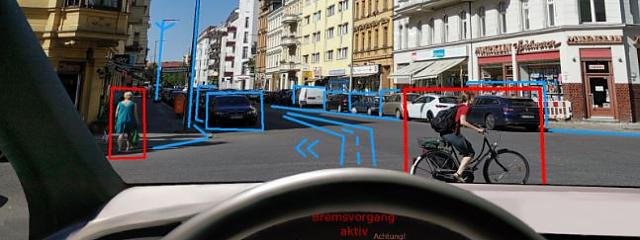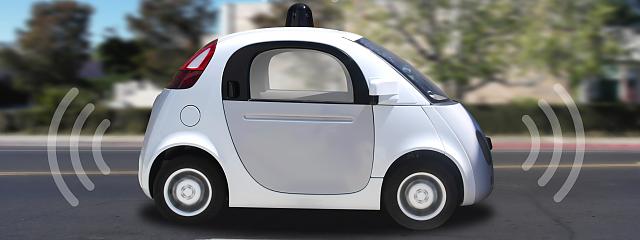
Autonomous cars on UK roads by 2021 - are cyclists safe?
Autonomous cars on UK roads by 2021 - are cyclists safe?
Early in February, the Automotive Minister Richard Harrington said it was the Government’s intention to move the country “towards having self-driving cars on our roads by 2021.”
The reasons are twofold, firstly the potential for increased road safety by removing the source of risk i.e the human driver. Secondly, with a new technology, early adapters and drivers of it have the best opportunity for reaping the financial benefits when there is widespread adoption, with current estimates suggesting the UK market for connected and automated vehicles will be worth £52bn by 2025.
As a cycling charity, it’s not our role to comment on Government industrial policy, unless of course it impacts on cycling in the UK – which in the case of AVs it could.
Cycling UK believes driverless technology has enormous potential to make our roads much safer – but equally we also believe their introduction if rushed and done incorrectly could end up doing great harm. It is our belief that a post-Brexit industry strategy should not place profit ahead of road safety, something which might result from a rushed introduction of automated vehicles.
As Cycling UK’s policy director, Roger Geffen MBE, said in his letter to The Times (08 Feb), “The government needs to proceed with extreme caution if it plans to allow driverless vehicles on our roads.”
The government needs to proceed with extreme caution if it plans to allow driverless vehicles on our roads.
Roger Geffen MBE, Cycling UK's policy director
We’re not being technological naysayers about this – there are already examples of autonomous cars being involved in fatal collisions with pedestrians and cyclists, such as in Arizona last March – what we’re saying is that there needs to be a staged introduction of AVs onto British roads – not a rushed one.
As we outlined in our submission to the Law Commission Review on Automated Vehicles, Cycling UK believes the staged introduction should be based on a “Vision Zero” approach. That means before we see the wider introduction of AVs there should be no deaths nor serious injuries caused by these vehicles.
The first stage of AVs should be on closed tracks, before progressing to motorways and perhaps to trunk roads with high-quality separated cycle tracks.
Only after several years in which ‘highly’ or ‘fully automated’ vehicles (ie those which can complete whole journeys without supervision) have demonstrated their reliability, not just by avoiding collisions with other motor vehicles, but also unexpected hazards (such as people at breakdowns and roadworks), should we then progress to the second stage of testing on local roads.
These need to be supervised trials of level 4 and above vehicles (ie more or less fully automated vehicles) by highly trained drivers on local roads where there is monitoring of both collisions and near misses. Again, a Vision Zero approach is needed until we see the general introduction of AVs on British Roads.
While it is important to have a staged approach, the lynchpin for their success is the introduction of a Road Accident Investigations Branch (AIB), such as we have for rail, air and maritime transport.
Currently there is no such body for our roads, but their success in maintaining the safety of passengers in rail, air and maritime travel in the UK has been exemplary. A large part of their success is the approach they take in their investigations when there has been an accident.
They start from a position of learning and designing out the danger that caused the accident, not from one which looks to apportion blame.
It’s been a remarkably successful approach, and is one Cycling UK wants to see available on our roads. We want to see careful monitoring of both collisions and near misses throughout both stages and only when the Road AIB decides there is no risk to other road users, should AV technology be allowed on our roads.
Such an approach would also negate the ethics question around AVs.
Autonomous Vehicles could be placed in a situation where they have make 'Sophie's choice' such as whether to save their passenger or hit another road user such as someone cycling. How can a machine make this decision?
Sam Jones, Cycling UK's Senior Campaigns and Communications officer
Many people have expressed concern that AVs could be placed in a situation where they have to make a tough choice as whether to save their passenger or hit another road user such as someone cycling. How can a machine make this decision – and more importantly should it be ?
However, if the testing phases are done correctly, then AVs should be designed in such a way that they will never be in the situation where they have to make such a decision, as they will have identified the potential danger long before it has appeared and taken appropriate action.
The introduction of AVs is also the opportunity to amend the UK’s existing laws on civil compensation, in the event of a collision between another road user and an AV. Cycling UK would like to the law to be updated so as create an assumption that a pedestrian, cyclist or other non-motorised road user who is injured in a collision with a motor vehicle, is entitled to claim damages from the ‘driver’, unless the victim is shown to have been at least partly at fault.
In practice, this means claiming against the driver’s insurance scheme, or in the case of an AV, the manufacturer’s insurer.
This principle of ‘presumed liability’ is actually a common practice throughout Europe, with only the UK, Republic of Ireland, Malta and Romania the exceptions. Cycling UK feels introducing presumed liability is necessary to prevent AVs from further worsening the imbalances in UK law.
At present, the burden is on the injured party – cyclist or pedestrian – to demonstrate the driver is at fault. This is all the more difficult when they might lack legal representation or have no memory of the collision due to their injuries.
Without a change to the law, and with AVs, there are additional hurdles, due to the lack of clarity about whether the claim is against the driver or the vehicle. If it’s the vehicle, then there is the possibility that the manufacturers may prove determined not to admit the flaws in their technology, making it all the more difficult for the victim to prove their innocence.
Introducing presumed liability would address these issues, and resolve the law’s current imbalance where road victims are effectively guilty until they can prove their innocence.
If the Government can follow all our recommendations, then our roads will become safer for everyone, not just people who cycle. They won’t achieve this by rushing through inadequately tested technology onto our roads.
When it comes to AVs, the Government would do well to heed its own advice to drivers: speed kills.













